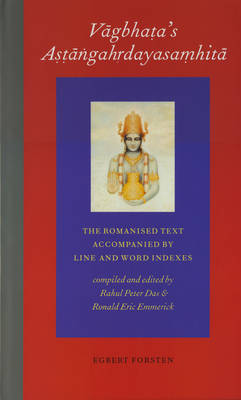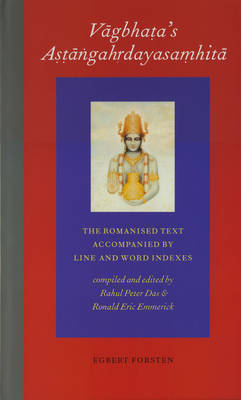
- Afhalen na 1 uur in een winkel met voorraad
- Gratis thuislevering in België vanaf € 30
- Ruim aanbod met 7 miljoen producten
- Afhalen na 1 uur in een winkel met voorraad
- Gratis thuislevering in België vanaf € 30
- Ruim aanbod met 7 miljoen producten
Zoeken
Vāgbhaṭa's Aṣṭāṅgahrdayasaṃhitā
The Romanised Text Accompanied by Line and Word Indexes
€ 335,95
+ 671 punten
Omschrijving
According to Indian tradition the Aṣṭāṅgahrdayasaṃhitā is regarded as one of the classical triad of āyurvedic treatises alongside those of Caraka and Suśruta. The name of its author, Vāgbhaṭa, was not uncommon, and concerning him little can be said with certainty. It seems probable, however, that the Vāgbhaṭa who was responsible for the Aṣṭāṅgahrdayasaṃhitā belonged to a North Indian family of physicians and that he flourished at the beginning of the seventh century of the Christian era. The Aṣṭāṅgahrdayasaṃhitā was by far the most famous of his works on Indian medical tradition and numerous commentators devoted themselves to its interpetation. It was perhaps for this reason that he himself wrote a commentary on it.
Vāgbhaṭa's Aṣṭāṅgahrdayasaṃhitā is remarkable in that it expressly attempts a synthesis of different schools of medicine, including those attributed to Caraka and Susruta. It was translated at an early date into Tibetan and became the foundation of the most authoritative treatise on medicine among the Tibetans, the so-called Rgyud Bíi.
Most of the later Indian medical writers are heavily indebted to Vāgbhaṭa's Aṣṭāṅgahrdayasaṃhitā and quote smaller or larger passages from it. The indexes provided by the present volume will enable the scholar easily to locate any quotation.
The present volume is primarily a tool for readers of Indian medical works. It contains the complete text of Vāgbhaṭa's Aṣṭāṅgahrdayasaṃhitā as constituted in the sixth edition of the text published by Aṇṇā Moreśvar Kuṇṭe and Krṣṇa Rāmcandra Śāstrī Navre. However, not only has the text been corrected wherever misprints were noticed but its orthography has been standardised so that words are spelled consistently irrespective of their source. On the basis of the text thus established, a word analysis of the text was made and finally the indexes to the lines and words of the text as published here.
Vāgbhaṭa's Aṣṭāṅgahrdayasaṃhitā is remarkable in that it expressly attempts a synthesis of different schools of medicine, including those attributed to Caraka and Susruta. It was translated at an early date into Tibetan and became the foundation of the most authoritative treatise on medicine among the Tibetans, the so-called Rgyud Bíi.
Most of the later Indian medical writers are heavily indebted to Vāgbhaṭa's Aṣṭāṅgahrdayasaṃhitā and quote smaller or larger passages from it. The indexes provided by the present volume will enable the scholar easily to locate any quotation.
The present volume is primarily a tool for readers of Indian medical works. It contains the complete text of Vāgbhaṭa's Aṣṭāṅgahrdayasaṃhitā as constituted in the sixth edition of the text published by Aṇṇā Moreśvar Kuṇṭe and Krṣṇa Rāmcandra Śāstrī Navre. However, not only has the text been corrected wherever misprints were noticed but its orthography has been standardised so that words are spelled consistently irrespective of their source. On the basis of the text thus established, a word analysis of the text was made and finally the indexes to the lines and words of the text as published here.
Specificaties
Betrokkenen
- Uitgeverij:
Inhoud
- Aantal bladzijden:
- 1036
- Taal:
- Engels
- Reeks:
- Reeksnummer:
- nr. 13
Eigenschappen
- Productcode (EAN):
- 9789069801049
- Verschijningsdatum:
- 1/01/1997
- Uitvoering:
- Hardcover
- Formaat:
- Genaaid
- Afmetingen:
- 221 mm x 325 mm
- Gewicht:
- 3583 g

Alleen bij Standaard Boekhandel
+ 671 punten op je klantenkaart van Standaard Boekhandel
Beoordelingen
We publiceren alleen reviews die voldoen aan de voorwaarden voor reviews. Bekijk onze voorwaarden voor reviews.







